Germany is Europe’s drug capital, sewage system research reveals
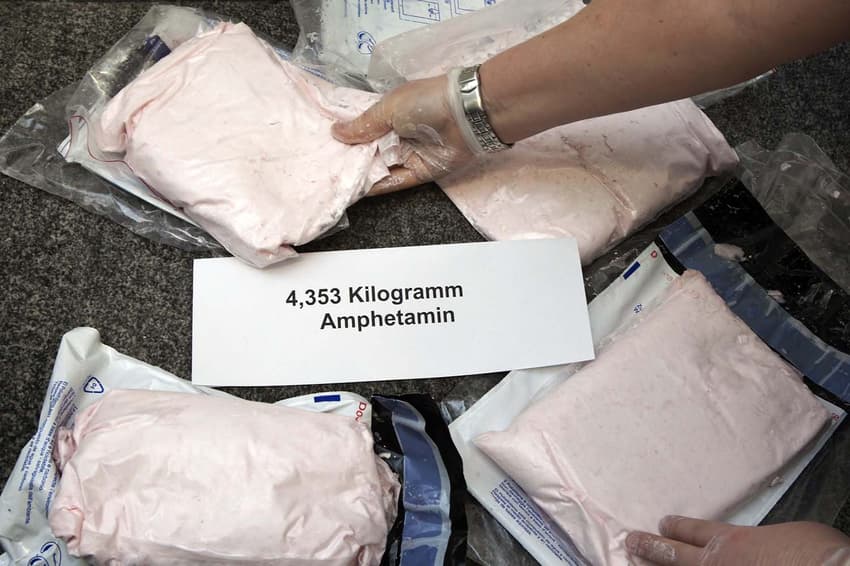
Four German cities - Saarbrücken, Erfurt, Dresden and Chemnitz - have the highest amphetamine consumption of anywhere in Europe, while cocaine and MDMA usage is on the rise in Dortmund and Berlin.
New research into wastewater across Europe indicates that Germany is the continent’s drug capital, particularly when it comes to amphetamine and methamphetamine. The data was collected by analyzing sewage and wastewater in more than 70 European cities and towns.
Conducted by the European Monitoring Centre for Drugs and Alcohol Addiction, the research confirmed some existing preconceptions about drug usage in Europe, while also revealing a number of surprises.
In the latest project, the researchers tested for four different drugs: cocaine, MDMA (ecstasy), amphetamine and methamphetamine (also known as ice, meth or crystal meth).
SEE ALSO: Aachen police find €25,000 worth of heroin disguised as happy meal
SEE ALSO: One year of medical marijuana in Germany
In particular, while MDMA and cocaine usage was high in ‘party cities’ like Amsterdam or wealthier banking cities like Zurich, Germany has a significant problem when it comes to amphetamines.
Saarbrücken is the continent’s undisputed capital of amphetamine usage, while three cities in the former east had the highest methamphetamine consumption anywhere in Europe.
European wastewater and drugs analysis
Wastewater analysis is an increasingly popular and effective research method. Originally starting as a way to study household chemical use, wastewater studies are effective where the reliability and honesty of participants may be in question - making it an ideal way to study drug consumption.
The researchers first began their project in 2011, studying the waste water of 19 European cities. The most recent project took into account 73 cities across 20 European countries.
The authors are careful to point out that increased levels do not necessarily indicate an increase in usage. Drugs such as cocaine have increased in purity in western Europe in recent years, which could be responsible for changes in trends.
João Matias, a Scientific Analyst with the EMCDAA, told The Local three main factors explain the instances of rapid or sudden increases in statistical findings regarding drug consumption: purity, amount taken by users or number of users.
“When we see a big increase from one year to the other in one city, it might be three reasons. More people are using it, the drug is purer - i.e. easier to detect in wastewater -- or the same number of people are using it as before but they are using it more frequently,” he said.
“Or it could be a combination of the three.”
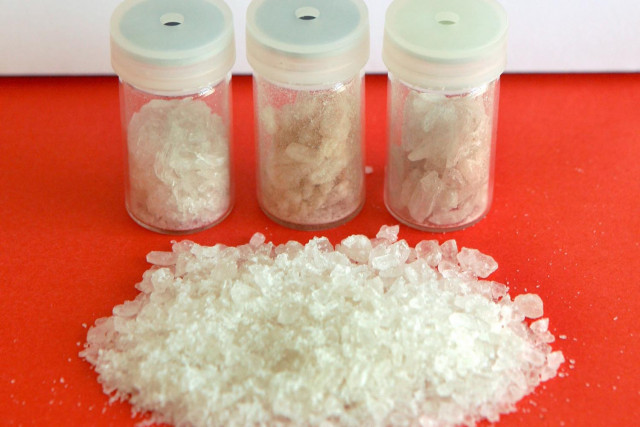
Amphetamine after a police seizure. Image: DPA
The data also doesn’t differentiate between who is using the drugs, just simply illustrating that the drugs are indeed being used.
The high rate of MDMA usage in Amsterdam - which per capita is almost double that of the closest non-Dutch city - is likely to have a lot to do with Amsterdam’s status as a party destination rather than an indication as to local usage.
Saarbrücken, Europe's amphetamine hub
Saarbrücken, the capital of Saarland with a population of 330,000, is also the undisputed European capital of amphetamine usage. With a daily consumption of 407mg per 1000 people, Saarbrücken consumes more than double that of the closest city on the list, Iceland’s Reykjavik (210mg).
Saarbrücken saw a massive increase in consumption from 2017 to 2018, with the latest figures a 68 percent increase from 2017’s figures (242mg).
There are two further German cities near the top of the list, with Dortmund (149mg) and Berlin (144mg) tenth and eleventh in Europe respectively.
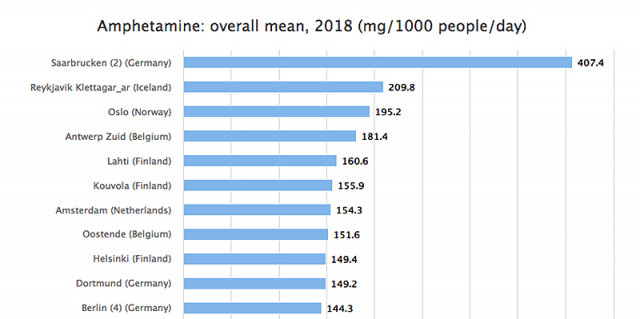
The use of amphetamine in Saarbrücken is around double that of second-placed Reykjavik. Chart courtesy EMCDDA.
As reported in the Saarbrücker Zeitung, state drug commissioner Stephan Kolling has said the results were “frightening” and promised to investigate. A study commissioned by the Saarland State Ministry of Health is set to be released in the coming months.
However, some have been critical of the results. Harald Schindel, from the Saarbrücken Security Department, has pointed out that the wastewater in the region not only comes from Saarbrücken, but also from neighbouring French and German regions. He says close to one third of the waste water is foreign -- i.e. not from Germany -- which may be behind the discrepancy.
Matias told The Local that while Saarbrücken was an outlier, consumption of amphetamines had increased on an unprecedented scale across the continent.
“Although the case of Saarbrücken is interesting because its quite a high level, one of the main findings from this year’s data collection is a big increase in amphetamines in many European cities,” he said.
“This is something we have seen for the first time.”
Matias added that the research revealed a change in the patterns of consumption and the preferences of drug users, with amphetamines now becoming increasingly popular as a party drug used on the weekends rather than on a daily basis.
“In previous years the daily amounts found were equal throughout different days of the week," he said. "We didn’t see a peak during the weekends as we would see for ecstasy and cocaine.”
“But this time in most cities the consumption of amphetamines increases on the weekends, which might imply that there is more recreational use.”
“Where people use it on a daily basis, the level will be consistent throughout the week.”
Methamphetamine
Methamphetamine -- a more potent and dangerous form of amphetamine -- was also incredibly popular in Germany. While the drug has historically been more popular in the Czech Republic, Slovakia and Finland, it has exploded in popularity in Germany in recent years.
The 2018 figures show that the top three cities for methamphetamine consumption in Europe are all in Germany. Erfurt (211mg/1000 people), Chemnitz (196mg) and Dresden (174) top the charts. Bratislava (Slovakia) and Brno (Czech Republic) rounding out the top five.
The same five cities made up the top five in 2017, although Chemnitz at that stage had the highest methamphetamine consumption with 240mg/1000 people per day.
Highlighting the popularity of the drug in the former east, the next closest German city on the list is Berlin, where daily consumption is 18mg per 1000 people.
Unlike amphetamines which can be prescribed by doctors in some instances -- for example to treat ADHD, eating disorders and narcolepsy -- methamphetamine is produced illegally.
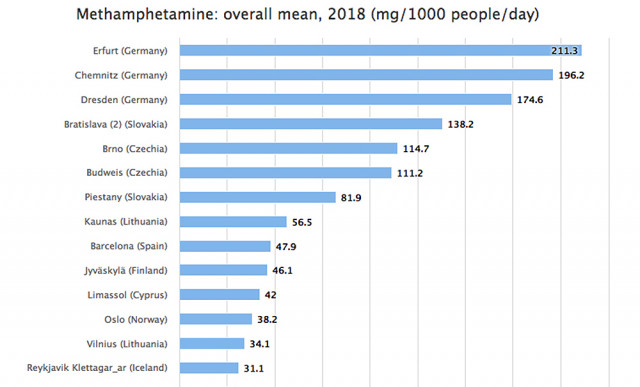
Methamphetamine has become increasingly popular in Germany, particularly in the former east. Chart courtesy EMCDDA.
Matias said that one of the major reasons for the increase in the former east was the proximity to the Czech Republic and Slovakia, which have historically been the centres of methamphetamine production in Europe.
“One of the reasons could be that the use of methamphetamine - and the production of methamphetamine - was historically linked to the Czech Republic and Slovakia. This might be one of the reasons why we see it now in the eastern part of Germany.”
‘Party drugs’: Everybody's working for the weekend
Through their measurements, the researchers were also able to isolate the times of the week when the drugs were consumed the most. Perhaps unsurprisingly, MDMA (ecstasy) and cocaine consumption peaked on the weekend, while consumption of amphetamines has also begun to increase over the weekends.
One of the major findings of the study was that drug usage wasn’t limited only to ‘party cities’ like Berlin, or wealthier cities like Munich. Dortmund had the highest cocaine usage in Germany, with 409.4 mg/1000 people per day. Berlin was second, with Munich in third place.
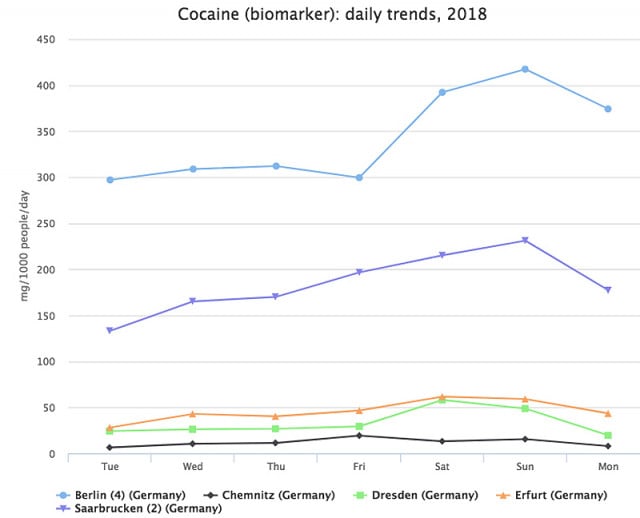
Average cocaine usage across the days of the week. Chart courtesy EMCDDA
While Dortmund was also responsible for the highest consumption levels in 2017, there was an 11 percent decrease in usage to 2018. Berlin on the other hand saw an 19 percent increase across the same period.
On a European scale, cocaine usage is still relatively low in German cities. Cocaine use is more than double in the top three cities on the list: Bristol (UK), Amsterdam (Netherlands) and Zurich (Switzerland).
MDMA consumption in Germany was highest in Berlin, where 60mg per 1000 people per day was detected. Saarbrücken was the only other city in Europe to rank in the top 20 (11th) with 36.3mg per 1000 people per day.
These numbers however paled in comparison to the European hub of MDMA consumption -- the Netherlands -- where 183mg per day per 1000 people was detected in Amsterdam and 160mg in Utrecht. Remarkably, this was a decrease on last year’s figures in the Dutch capital.
p.p1 {margin: 0.0px 0.0px 0.0px 0.0px; font: 12.0px Helvetica}
p.p2 {margin: 0.0px 0.0px 0.0px 0.0px; font: 12.0px Helvetica; min-height: 14.0px}
Comments
See Also
New research into wastewater across Europe indicates that Germany is the continent’s drug capital, particularly when it comes to amphetamine and methamphetamine. The data was collected by analyzing sewage and wastewater in more than 70 European cities and towns.
Conducted by the European Monitoring Centre for Drugs and Alcohol Addiction, the research confirmed some existing preconceptions about drug usage in Europe, while also revealing a number of surprises.
In the latest project, the researchers tested for four different drugs: cocaine, MDMA (ecstasy), amphetamine and methamphetamine (also known as ice, meth or crystal meth).
SEE ALSO: Aachen police find €25,000 worth of heroin disguised as happy meal
SEE ALSO: One year of medical marijuana in Germany
In particular, while MDMA and cocaine usage was high in ‘party cities’ like Amsterdam or wealthier banking cities like Zurich, Germany has a significant problem when it comes to amphetamines.
Saarbrücken is the continent’s undisputed capital of amphetamine usage, while three cities in the former east had the highest methamphetamine consumption anywhere in Europe.
European wastewater and drugs analysis
Wastewater analysis is an increasingly popular and effective research method. Originally starting as a way to study household chemical use, wastewater studies are effective where the reliability and honesty of participants may be in question - making it an ideal way to study drug consumption.
The researchers first began their project in 2011, studying the waste water of 19 European cities. The most recent project took into account 73 cities across 20 European countries.
The authors are careful to point out that increased levels do not necessarily indicate an increase in usage. Drugs such as cocaine have increased in purity in western Europe in recent years, which could be responsible for changes in trends.
João Matias, a Scientific Analyst with the EMCDAA, told The Local three main factors explain the instances of rapid or sudden increases in statistical findings regarding drug consumption: purity, amount taken by users or number of users.
“When we see a big increase from one year to the other in one city, it might be three reasons. More people are using it, the drug is purer - i.e. easier to detect in wastewater -- or the same number of people are using it as before but they are using it more frequently,” he said.
“Or it could be a combination of the three.”

Amphetamine after a police seizure. Image: DPA
The data also doesn’t differentiate between who is using the drugs, just simply illustrating that the drugs are indeed being used.
The high rate of MDMA usage in Amsterdam - which per capita is almost double that of the closest non-Dutch city - is likely to have a lot to do with Amsterdam’s status as a party destination rather than an indication as to local usage.
Saarbrücken, Europe's amphetamine hub
Saarbrücken, the capital of Saarland with a population of 330,000, is also the undisputed European capital of amphetamine usage. With a daily consumption of 407mg per 1000 people, Saarbrücken consumes more than double that of the closest city on the list, Iceland’s Reykjavik (210mg).
Saarbrücken saw a massive increase in consumption from 2017 to 2018, with the latest figures a 68 percent increase from 2017’s figures (242mg).
There are two further German cities near the top of the list, with Dortmund (149mg) and Berlin (144mg) tenth and eleventh in Europe respectively.

The use of amphetamine in Saarbrücken is around double that of second-placed Reykjavik. Chart courtesy EMCDDA.
As reported in the Saarbrücker Zeitung, state drug commissioner Stephan Kolling has said the results were “frightening” and promised to investigate. A study commissioned by the Saarland State Ministry of Health is set to be released in the coming months.
However, some have been critical of the results. Harald Schindel, from the Saarbrücken Security Department, has pointed out that the wastewater in the region not only comes from Saarbrücken, but also from neighbouring French and German regions. He says close to one third of the waste water is foreign -- i.e. not from Germany -- which may be behind the discrepancy.
Matias told The Local that while Saarbrücken was an outlier, consumption of amphetamines had increased on an unprecedented scale across the continent.
“Although the case of Saarbrücken is interesting because its quite a high level, one of the main findings from this year’s data collection is a big increase in amphetamines in many European cities,” he said.
“This is something we have seen for the first time.”
Matias added that the research revealed a change in the patterns of consumption and the preferences of drug users, with amphetamines now becoming increasingly popular as a party drug used on the weekends rather than on a daily basis.
“In previous years the daily amounts found were equal throughout different days of the week," he said. "We didn’t see a peak during the weekends as we would see for ecstasy and cocaine.”
“But this time in most cities the consumption of amphetamines increases on the weekends, which might imply that there is more recreational use.”
“Where people use it on a daily basis, the level will be consistent throughout the week.”
Methamphetamine
Methamphetamine -- a more potent and dangerous form of amphetamine -- was also incredibly popular in Germany. While the drug has historically been more popular in the Czech Republic, Slovakia and Finland, it has exploded in popularity in Germany in recent years.
The 2018 figures show that the top three cities for methamphetamine consumption in Europe are all in Germany. Erfurt (211mg/1000 people), Chemnitz (196mg) and Dresden (174) top the charts. Bratislava (Slovakia) and Brno (Czech Republic) rounding out the top five.
The same five cities made up the top five in 2017, although Chemnitz at that stage had the highest methamphetamine consumption with 240mg/1000 people per day.
Highlighting the popularity of the drug in the former east, the next closest German city on the list is Berlin, where daily consumption is 18mg per 1000 people.
Unlike amphetamines which can be prescribed by doctors in some instances -- for example to treat ADHD, eating disorders and narcolepsy -- methamphetamine is produced illegally.

Methamphetamine has become increasingly popular in Germany, particularly in the former east. Chart courtesy EMCDDA.
Matias said that one of the major reasons for the increase in the former east was the proximity to the Czech Republic and Slovakia, which have historically been the centres of methamphetamine production in Europe.
“One of the reasons could be that the use of methamphetamine - and the production of methamphetamine - was historically linked to the Czech Republic and Slovakia. This might be one of the reasons why we see it now in the eastern part of Germany.”
‘Party drugs’: Everybody's working for the weekend
Through their measurements, the researchers were also able to isolate the times of the week when the drugs were consumed the most. Perhaps unsurprisingly, MDMA (ecstasy) and cocaine consumption peaked on the weekend, while consumption of amphetamines has also begun to increase over the weekends.
One of the major findings of the study was that drug usage wasn’t limited only to ‘party cities’ like Berlin, or wealthier cities like Munich. Dortmund had the highest cocaine usage in Germany, with 409.4 mg/1000 people per day. Berlin was second, with Munich in third place.

Average cocaine usage across the days of the week. Chart courtesy EMCDDA
While Dortmund was also responsible for the highest consumption levels in 2017, there was an 11 percent decrease in usage to 2018. Berlin on the other hand saw an 19 percent increase across the same period.
On a European scale, cocaine usage is still relatively low in German cities. Cocaine use is more than double in the top three cities on the list: Bristol (UK), Amsterdam (Netherlands) and Zurich (Switzerland).
MDMA consumption in Germany was highest in Berlin, where 60mg per 1000 people per day was detected. Saarbrücken was the only other city in Europe to rank in the top 20 (11th) with 36.3mg per 1000 people per day.
These numbers however paled in comparison to the European hub of MDMA consumption -- the Netherlands -- where 183mg per day per 1000 people was detected in Amsterdam and 160mg in Utrecht. Remarkably, this was a decrease on last year’s figures in the Dutch capital.
p.p1 {margin: 0.0px 0.0px 0.0px 0.0px; font: 12.0px Helvetica} p.p2 {margin: 0.0px 0.0px 0.0px 0.0px; font: 12.0px Helvetica; min-height: 14.0px}
Join the conversation in our comments section below. Share your own views and experience and if you have a question or suggestion for our journalists then email us at [email protected].
Please keep comments civil, constructive and on topic – and make sure to read our terms of use before getting involved.
Please log in here to leave a comment.